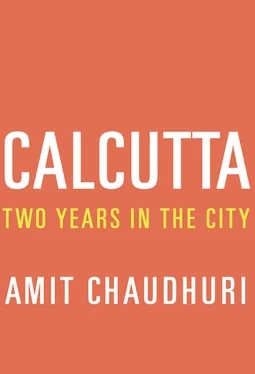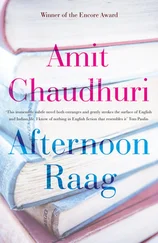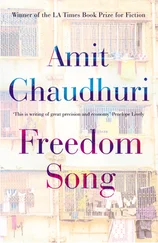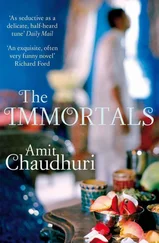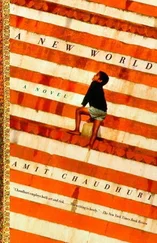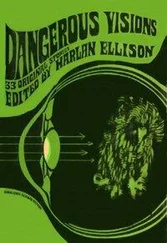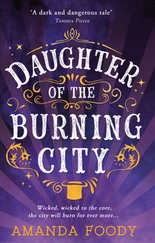What takes place in the malls seems unconnected to what’s happening in Calcutta, or West Bengal, or even to markets globally — I say this as one who’s visited them when things looked optimistic for the Left Front; when the future became murky for them; after they were jettisoned; before the recession; after the Indian markets limped back to life. The new breed has found its own rhythm here, a rhythm that might be hard to decipher, but difficult to deny. This is also where — besides exploring their options and assessing each other — they appear to find themselves. Never have I seen, in malls in other countries, the number of people I’ve noticed at South City or the Forum leaning against balconies, studying the lower levels, or the people ascending, apparition-like, on the escalator. It might be a mood that’s an offshoot of our weather (with its warmth and torpor) which gives us, childhood onward, a lonely, godlike vantage point on life. I know that to spectate thus on the movements of other people is a deep comfort to the purposeless and the homesick. I had a friend in Bombay, a classmate from school who couldn’t kick his drug habit, who, every twenty minutes into our conversation, would go out into the balcony, to involuntarily lean upon the banister and regain his inner calm. I’ve also noticed, often by chance, the silhouettes of maids who’ve worked and lived in our apartment, leaning and looking out into the compound while the world grows dark. What do they see?
In the South City Mall, especially, with its bewildering turnover, I’ve almost felt emboldened to stop passers-by and ask them where they’re going — what they’re doing here; what they want to buy; where they come from. I haven’t done so. The only time I approached someone out of the blue within the mall’s special shell, unintroduced, was when, ascending to level two, I was startled to see five or six large African men ranged gracefully across the balcony. They turned out to be Nigerian soccer players in the employ of Mohammedan Sporting Club; celebrities with a tentative air, desiring, impossibly, not to be noticed, and somehow achieving this desire. From maybe the beginning of the twentieth century, football had been the prime passion in sport in Bengal, and, in the late seventies, the game was commercialised unbelievably, with star players departing for rival teams for the lure of a big reward, in the manner of their better-known European counterparts. Team coaches emerged as indefatigable personalities in their own right — the balding P. K. Banerjee, referred to as “Peekay,” once a star footballer himself, became the immensely successful brain behind East Bengal and, later, its rival, Mohun Bagan. Of course, Bengali football (synonymous, then, with Indian football) was played on a planet distinct from the one international football thrived in; football persisted in Calcutta as many obsessions did, as a miniaturist’s art, undertaken ferociously but microscopically, for its own delight.
In the eighties, the three main clubs — East Bengal, Mohun Bagan, and Mohammedan — began to acquire foreign — mainly African — players, who were admired by crowds for their skills, and for being strange trophies in a culture that possessed few of these. The most famous of them remains the striker Chima Okorie, who played for all the big teams. In the meanwhile, cricket was in the ascendancy, and, although Bengal produced no cricketer of charisma until Sourav Ganguly’s debut in 1996, football was gradually removed from the sphere of middle-class enthusiasm, and became — along with gutka and betel leaves — largely a proletarian addiction.
So it was an education to run into the Nigerians in the mall, and to be reminded of just how out of place they were — not because of their race, but their casual urbaneness. They let down their guard a bit when I said I was a writer; we even talked about Nigerian writing (who knows when national literatures will come in useful?), and Achebe came up immediately, and then, to my surprise, even his near namesake, Adichie — Chimamanda Adichie — whom one of them had heard of (“She’s a young writer,” the tall man said to the other, for whom Achebe encompassed all Nigerian writing) and whom I claimed to know slightly. I then asked them the unavoidable banality— What do you think of Calcutta? — and though they weren’t forthcoming or eloquent, they admitted, in a non-committal way, to loving the mall, and said they returned a few times weekly.
* * *
The Italian problem was suddenly brought home to me again, in the monsoons of 2011, when a team from the New York Times style magazine came down to Calcutta to produce a feature. The core of the team was a father and son — Max Vadukul, the photographer, whom I’d met fourteen years earlier in London for an infamous New Yorker photo shoot of Indian writers, and fresh-faced young Alex, who’d just begun his career as a journalist. The two had been thrown together by the editor, and concluded that, so far, in the last twenty-four hours, working with each other had been fine. The editor, who apparently had an unerring instinct in such matters, had told them she had a powerful feeling that Calcutta was the new “happening city.” “It’s where you have to go,” she’d advised Max and Alex. They’d come armed with the knowledge that this was the place that had given birth to “all the writers, intellectuals, artists, and film-makers,” that it was a city of culture, and they radiated outward in various directions from the Grand Hotel, where they were located, looking at the city before them in this pre-ordained light. It was a bit like visiting modern Athens and believing you were in ancient Greece; and, certainly, there are enough surviving ruins and monuments in Athens to sustain, if you so choose to, that make-believe. In Calcutta, though the time lag, in comparison, is much smaller, it’s more difficult to confuse this city with that other one, from whence came “all the writers, intellectuals, artists, and film-makers.” But maybe it seems that way to me because I’m both an outsider, out of sympathy, and not as much one as Alex and Max are.
On their last evening here, Max generously offered to take R and me out to dinner. “No, not Bengali food,” he said. “We’ve eaten enough Bengali food.” R, opportunely, suggested a place we’d only lately heard of — an Italian restaurant with an Italian chef that had sprung up near Menaka Cinema and the lakes: for me, the domain of childhood, a short walk from Bhowanipore and my uncle’s house — the short stretch of world I’d reimagined for the purposes of A Strange and Sublime Address . How could there possibly be a new Italian restaurant here, in a place that stood, for me, in the interstices of the literature of neighbourhood, my own writing, and my first intimation of what a city was? “Casa Toscana,” said my wife; it had been preying on her mind. “Casa Toscana it is!” said Max; and Alex, who was still taking things at face value, and is half-Italian, added, “I like Tuscan food.”
The restaurant was crowded; there was no table to be had. Often, a restaurant — especially if it’s an old one, or a European eatery, or akin to a cafe — will transport you to a foreign city; it’ll fill you with a fleeting conviction that the street outside the glass window is strange. In Casa Toscana, I experienced another kind of déjà vu and confusion; that I was in Bombay — not in the city in which I’d grown up, but today’s lit-up Bombay, where people of all kinds, rich and poor, Indian and Western, arrive to fulfil some need. Casa Toscana was bathed in that pink light. For the first time, I sensed that globalisation was here , in Calcutta. Two tall, anorexic European women, one blonde, the other’s hair dyed jet black, were coldly receiving customers and checking if they had bookings. I tried my charm on them, and even mentioned the New York Times ; Alex was disarming, leaning past me to say, “Italiano?” What better topping could this new eating place come with than to have Italian hostesses escort Calcuttans to an Italian supper? “No, I’m Croatian,” she said, in a precise accent I’ve frequently overheard in London, and with the preliminary iciness that East European women have before they become loquacious. Both Alex and I felt humbled, provincial, as people from Calcutta or London or New York often do in Bombay. There’s something about the unprecedented, blasé mix of globalised India that’s nervous-making, and threatens to make you forget your education, and feel diminished and small. Nevertheless, we were given a table, largely because of the slightly inscrutable but obliging proprietor, Saket, who, Pilate-like, sized us up in a glance and, for whatever reason, thought we were a worthwhile investment. We were guided past the clink of the cutlery and the din of customers by the dark-haired woman, who informed me cheerfully she was Russian. (I had a premonition, then, of some story involving restiveness and deprivation, accentuated to me by her thinness, and knew that moment that I wanted to interview her and the blonde woman, but was tardy on the draw; when I phoned the restaurant two months later, their contracts had ended and they’d left Calcutta, for either fresh pastures or old.)
Читать дальше
